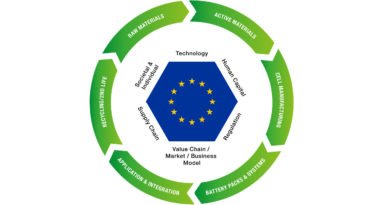
The European Chips Act: It’s Now or Never
When the European Chips Act came into effect in 2022, it was meant to awaken European consciousness regarding semiconductor production and industrial sovereignty. Considering the sector’s critical role in the global economy, it’s time for Europe to wake up and give itself a better chance in securing its position in semiconductor design and production before it’s too late.
With a target to produce 20% of the world’s chips (Europe currently only has a 10% market share), the Act is both ambitious and pragmatic, given the current landscape and the sector’s vital role in the global economy. However, Europe’s industrial sovereignty is at stake. Indeed, critical industries driving growth around the world depend on a robust supply of semiconductor technology. Vehicle electrification, autonomous driving, artificial intelligence, cloud computing, space, renewable energy, supercomputers, connectivity, telecommunications, defense… all depend on these chips for both innovation and stability.
The European Chips Act was designed to awaken European awareness of semiconductors’ strategic importance.
Unfortunately, the Act has yet to catalyze the extensive mobilization required for its successful implementation. As global chip shortage threatens key industries, a lack of bold action risks Europe falling behind, even if it does have foundations worth developing.
The reality of the European semiconductor industry
Despite an ecosystem currently less than conducive to long-term success, there are encouraging signs that Europe is prepared to make strides in the right direction. Certain firms within the EU are showing promise as drivers of innovation, offering a foundation upon which the region can build long-term market resilience and stability. One such example is SiPearl, a French startup developing Europe’s first energy-efficient microprocessor for high-performance computing (HPC) and AI applications.
SiPearl’s innovations are critical for Europe’s push toward technological sovereignty, particularly in areas such as AI, medical research, security, climate modelling, and energy management. “Our aim is to give Europe and all our users greater sovereignty, particularly in relation to the United States while building a leading position in the global application markets of artificial intelligence and supercomputers. This European sovereignty can be embraced by other countries outside Europe because we share the same values of independence,” CEO Philippe Notton has stated, underscoring the ambitious approach at the firm.
Indeed, the European Union has backed the creation of new semiconductor research and development hubs, including a planned advanced packaging facility aimed at enhancing the continent’s chip design and manufacturing capabilities. Strategic partnerships are also playing a crucial role; for instance, ASML remains a dominant player in extreme ultraviolet (EUV) lithography technology—a key process in advanced chip manufacturing. Luc Van den Hove, CEO of semiconductor research firm IMEC, suggests that Europe should focus on bolstering its strengths in research and as a producer of crucial chipmaking equipment, rather than attempting to create cutting-edge chip manufacturing capabilities from scratch. He notes,
“You can’t make an advanced chip without European technology,” underscoring Europe’s vital role in the global semiconductor supply chain.
Things could change quickly, however, with the recent news that Huawei, the Chinese electronics giant, is trying to develop its own EUV lithography.
However, industry leaders are expressing caution regarding Europe’s ambitions. Peter Wennink, then CEO of ASML, has remarked on the European Commission’s target to secure 20% of the global chip market by 2030, stating, “It’s totally unrealistic.” He emphasizes that Europe’s current share is “8% at best,” and achieving the proposed increase would require substantial and rapid expansion of manufacturing capacity. The German Electrical and Electronic Manufacturers’ Association (ZVEI) has emphasised that the current level of support is insufficient to achieve the EU’s goal of capturing 20% of global chip manufacturing capacity by 2030. “Europe is threatened with a further decline in production capacities and could become a pawn of geopolitical power interests,” warned ZVEI president Gunther Kegel, in a statement.
Without increased efforts, Europe’s share is projected to decline from the current 8.1% to 5.9%, as other regions intensify their initiatives. This perspective highlights the challenges Europe faces in scaling its semiconductor industry to meet global demands. While companies like NXP, ASML, SiPearl or Infineon Technologies are making notable progress, European progress remains labored. And these isolated successes do not compensate for the overall lack of large-scale industrial mobilization. In concrete terms, Europe is facing both cyclical and structural difficulties, its main problem being a lack of anticipation, meaning decisions are being made at the wrong time. This lack of anticipation can be seen when it comes to growing delays in the construction of plants in Europe. A ‘logical’ situation, according to SiPearl’s CEO Philippe Notton, who explains that “there is no market.
Building a plant with advanced capabilities in Europe is all the more difficult because there is no product, no start-up, and no financing behind it.
There is a high risk that the plant will be under-operated.” The Chips Act has yet to generate the kind of rapid investment and innovation surge seen in the U.S. and Asia, leaving Europe at a pivotal moment where decisive action is needed to avoid further decline.
A lot of work to be done
A lack of private sector investment and a growing talent shortage continue to hinder Europe’s semiconductor ambitions, with companies struggling to secure funding and skilled professionals for R&D and manufacturing. Infineon Technologies’ recent decision to cut 1,400 jobs and relocate another 1,400 positions due to a market surplus highlights the broader challenges, as declining orders in key sectors like smartphones, automotive, and industrial machinery further strain the industry. Moreover, the complex regulatory environment in Europe has also created bureaucratic hurdles that delay funding distribution and project approvals, making it difficult for startups and existing companies to scale up manufacturing.
China, Taiwan, South Korea and the United States, on the other hand, have all accelerated the development of critical semiconductor manufacturing capabilities that threaten to leave Europe by the wayside. While the EU has allocated €43 billion for the Chips Act initiative, industry experts argue this is not enough to compete with the significantly larger investments from the U.S. CHIPS and Science Act ($52 billion) and China’s semiconductor subsidies (estimated at $150 billion by 2030). So, strengthening Europe’s domestic production is critical to navigating geopolitical instability, market volatility, and trade tensions, particularly given U.S. President Donald Trump’s aggressive tariff policies toward American allies. Indeed, Trump has already threatened to put tariffs on foreign computer chips and semiconductors “in the near future.” No decision has yet been taken, but the announcement by Taiwan’s TSMC that it will invest $100 billion to manufacture more cutting-edge chips in the United States seems to have been prompted by fears of a possible customs war.
The U.S. threat
Alongside the threat of a trade war coming from the White House, the new Trump administration announced the launching of the Stargate project, a $500bn joint investment initiative focused on building domestic artificial intelligence infrastructure, and the removal of President Biden’s executive order on AI safety that aimed to reduce the risks that artificial intelligence poses to consumers, workers and national security. This large-scale effort involves massive subsidies for domestic chip production, stricter export controls, and a push to onshore high-end fabrication technologies, effectively cutting off foreign competitors, including Europe, from critical semiconductor advancements.
If extended to European companies, these restrictions could limit access to AI chips, fabrication tools, and advanced semiconductor components, putting the EU at a severe disadvantage. Furthermore, by prioritizing U.S. semiconductor independence, Stargate could draw talent (and increase high-skilled labor shortage), investment, and supply chain agreements away from Europe, exacerbating the region’s existing struggles with innovation and production capacity. France has decided to take action with the announcement of $112 billion of investment in artificial intelligence. These investments will be phased in over several years and should enable France to get back into the global race at a time when the clouds are gathering over the European continent with the decision to limit American exports of the most advanced chips to certain European countries.
Time to act
While the U.S., China, Taiwan, South Korea – and even more recently Japan with the 30 billion project Rapidus – race ahead in semiconductors and AI, Europe remains a secondary player struggling to assert itself. In AI, Europe is even more vulnerable, lacking major industry leaders comparable to NVIDIA, Google, or OpenAI. With AI chip production concentrated in the U.S. and China, European firms risk falling behind in critical innovations, and doubling down on their dependence on foreign technology. If the EU does not respond with stronger policies and increased investments, it will face not only stagnation, but an accelerating technological decline, leaving its digital future increasingly in the hands of external powers.
Europe stands at a critical juncture in the global semiconductor race, and without decisive action, its ambitions risk fading into irrelevance.
To secure real sovereignty, the European Chips Act must go beyond its current framework by strategically reallocating and increasing funds, encouraging companies that embrace innovation and ensuring that investments are directed toward cutting-edge semiconductor technologies rather than just expanding general production. The urgency cannot be overstated—without immediate reinforcements, the Chips Act will fall short of its objectives, leaving Europe increasingly dependent on external powers for its technological future.




